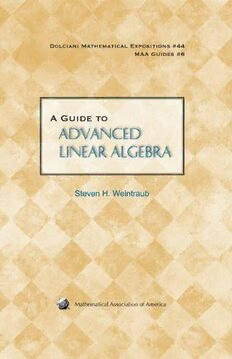Table Of Contenti i
“book” — 2011/3/4 — 17:06 — page i — #1
i i
A Guide
to
Advanced Linear Algebra
i i
i i
i i
“book” — 2011/3/4 — 17:06 — page ii — #2
i i
(cid:13)c 2011by
TheMathematicalAssociationofAmerica(Incorporated)
LibraryofCongressCatalogCardNumber2011923993
PrintEditionISBN978-0-88385-351-1
ElectronicEditionISBN978-0-88385-967-4
PrintedintheUnitedStatesofAmerica
CurrentPrinting(lastdigit):
10987654321
i i
i i
i i
“book” — 2011/3/4 — 17:06 — page iii — #3
i i
TheDolcianiMathematicalExpositions
NUMBERFORTY-FOUR
MAAGuides#6
A Guide
to
Advanced Linear Algebra
Steven H. Weintraub
Lehigh University
PublishedandDistributedby
TheMathematicalAssociationofAmerica
i i
i i
i i
“book” — 2011/3/4 — 17:06 — page iv — #4
i i
DOLCIANIMATHEMATICALEXPOSITIONS
CommitteeonBooks
FrankFarris,Chair
DolcianiMathematicalExpositionsEditorialBoard
UnderwoodDudley,Editor
JeremyS.Case
RosalieA.Dance
TevianDray
ThomasM.Halverson
PatriciaB.Humphrey
MichaelJ.McAsey
MichaelJ.Mossinghoff
JonathanRogness
ThomasQ.Sibley
i i
i i
i i
“book” — 2011/3/4 — 17:06 — page v — #5
i i
The DOLCIANI MATHEMATICAL EXPOSITIONS series of the Mathematical
AssociationofAmericawasestablishedthroughagenerousgifttotheAssociation
fromMaryP.Dolciani,ProfessorofMathematicsatHunterCollegeoftheCityUni-
versityofNewYork.Inmakingthegift,ProfessorDolciani,herselfanexceptionally
talentedandsuccessfulexpositorofmathematics,hadthepurposeoffurtheringthe
idealofexcellenceinmathematicalexposition.
TheAssociation,foritspart,wasdelightedtoacceptthegraciousgestureinitiat-
ingtherevolvingfundforthisseriesfromonewhohasservedtheAssociationwith
distinction,bothasamemberoftheCommitteeonPublicationsandasamemberof
theBoardofGovernors.ItwaswithgenuinepleasurethattheBoardchosetoname
theseriesinherhonor.
Thebooksintheseriesareselectedfortheirlucidexpositorystyleandstimu-
latingmathematicalcontent.Typically,theycontainanamplesupplyofexercises,
manywithaccompanyingsolutions.Theyareintendedtobesufficientlyelementary
fortheundergraduateandeventhemathematicallyinclinedhigh-schoolstudentto
understandandenjoy,butalsoto beinterestingandsometimeschallengingto the
moreadvancedmathematician.
1. MathematicalGems,RossHonsberger
2. MathematicalGemsII,RossHonsberger
3. MathematicalMorsels,RossHonsberger
4. MathematicalPlums,RossHonsberger(ed.)
5. GreatMomentsinMathematics(Before1650),HowardEves
6. MaximaandMinimawithoutCalculus,IvanNiven
7. GreatMomentsinMathematics(After1650),HowardEves
8. MapColoring,Polyhedra,andtheFour-ColorProblem,DavidBarnette
9. MathematicalGemsIII,RossHonsberger
10. MoreMathematicalMorsels,RossHonsberger
11. Old and New Unsolved Problems in Plane Geometry and Number Theory,
VictorKleeandStanWagon
12. ProblemsforMathematicians,YoungandOld,PaulR.Halmos
13. Excursions in Calculus: An Interplay of the Continuous and the Discrete,
RobertM.Young
14. TheWohascumCountyProblemBook,GeorgeT.Gilbert,MarkKrusemeyer,
andLorenC.Larson
15. LionHuntingandOtherMathematicalPursuits:ACollectionofMathematics,
Verse,andStoriesbyRalphP.Boas,Jr.,editedbyGeraldL.Alexandersonand
DaleH.Mugler
16. LinearAlgebraProblemBook,PaulR.Halmos
17. FromErdo˝stoKiev:ProblemsofOlympiadCaliber,RossHonsberger
18. WhichWayDidtheBicycleGo?...andOtherIntriguingMathematicalMys-
teries,JosephD.E.Konhauser,DanVelleman,andStanWagon
i i
i i
i i
“book” — 2011/3/4 — 17:06 — page vi — #6
i i
19. InPo´lya’sFootsteps:MiscellaneousProblemsandEssays,RossHonsberger
20. DiophantusandDiophantineEquations,I.G.Bashmakova(UpdatedbyJoseph
SilvermanandtranslatedbyAbeShenitzer)
21. LogicasAlgebra,PaulHalmosandStevenGivant
22. Euler:TheMasterofUsAll,WilliamDunham
23. TheBeginningsandEvolutionofAlgebra,I.G.BashmakovaandG.S.Smirnova
(TranslatedbyAbeShenitzer)
24. MathematicalChestnutsfromAroundtheWorld,RossHonsberger
25. CountingonFrameworks:MathematicstoAidtheDesignofRigidStructures,
JackE.Graver
26. MathematicalDiamonds,RossHonsberger
27. ProofsthatReallyCount:TheArtofCombinatorialProof,ArthurT.Benjamin
andJenniferJ.Quinn
28. MathematicalDelights,RossHonsberger
29. Conics,KeithKendig
30. Hesiod’s Anvil: falling and spinning through heavenand earth, Andrew J.
Simoson
31. AGardenofIntegrals,FrankE.Burk
32. AGuidetoComplexVariables(MAAGuides#1),StevenG.Krantz
33. SinkorFloat?ThoughtProblemsinMathandPhysics,KeithKendig
34. BiscuitsofNumberTheory,ArthurT.BenjaminandEzraBrown
35. UncommonMathematical Excursions:Polynomia andRelated Realms,Dan
Kalman
36. WhenLessisMore:VisualizingBasicInequalities,ClaudiAlsinaandRoger
B.Nelsen
37. AGuidetoAdvancedRealAnalysis(MAAGuides#2),GeraldB.Folland
38. AGuidetoRealVariables(MAAGuides#3),StevenG.Krantz
39. Voltaire’s Riddle: Microme´gas and the measure of all things, Andrew J.
Simoson
40. AGuidetoTopology,(MAAGuides#4),StevenG.Krantz
41. AGuidetoElementaryNumberTheory,(MAAGuides#5),UnderwoodDud-
ley
42. Charming Proofs: A Journeyinto Elegant Mathematics, Claudi Alsina and
RogerB.Nelsen
43. MathematicsandSports,editedbyJosephA.Gallian
44. AGuidetoAdvancedLinearAlgebra,(MAAGuides#6),StevenH.Weintraub
MAAServiceCenter
P.O.Box91112
Washington,DC20090-1112
1-800-331-1MAA FAX:1-301-206-9789
i i
i i
i i
“book” — 2011/3/4 — 17:06 — page vii — #7
i i
Preface
Linear algebra is a beautifuland mature field ofmathematics, and mathe-
maticianshavedevelopedhighlyeffectivemethodsforsolvingitsproblems.
Itisasubjectwellworthstudyingforitsownsake.
Morethanthat,linearalgebraoccupiesacentralplaceinmodernmath-
ematics. Students in algebra studying Galois theory, students in analysis
studyingfunctionspaces, studentsintopologystudyinghomologyandco-
homology,orforthatmatterstudentsinjustaboutanyareaofmathematics,
studyingjustaboutanything,needtohaveasoundknowledgeoflinearal-
gebra.
Wehavewrittenabookthatwehopewillbebroadlyuseful.Thecoreof
linearalgebraisessentialtoeverymathematician,andwenotonlytreatthis
core, butaddmaterialthatisessentialtomathematiciansinspecific fields,
evenifnotallofitisessentialtoeverybody.
Thisisabookforadvancedstudents.Wepresumeyouarealreadyfamil-
iarwithelementarylinearalgebra,andthatyouknowhowtomultiplyma-
trices, solvelinearsystems, etc. We donottreatelementary material here,
thoughin places we return to elementary material from a more advanced
standpointtoshowyouwhatitreallymeans. However,wedonotpresume
youarealreadyamaturemathematician,andinplacesweexplainwhat(we
feel)isthe“right”waytounderstandthematerial.Theauthorfeelsthatone
ofthemaindutiesofateacheristoprovideaviewpointonthesubject,and
wetakepainstodothathere.
Onethingthatyoushouldlearnaboutlinearalgebranow,ifyouhavenot
alreadydoneso,isthefollowing:Linearalgebraisaboutvectorspacesand
lineartransformations,notaboutmatrices.Thisisverymuchtheapproach
ofthisbook,asyouwillseeuponreadingit.
We treat both the finite and infinite dimensional cases in this book,
and point out the differences between them, but the bulk of our attention
isdevoted tothefinitedimensionalcase. There are tworeasons:First, the
vii
i i
i i
i i
“book” — 2011/3/4 — 17:06 — page viii — #8
i i
viii A GuidetoAdvanced Linear Algebra
strongestresultsareavailablehere,andsecond,thisisthecasemostwidely
used in mathematics. (Of course, matrices are available only in the finite
dimensionalcase,but,evenhere,wealmostalwaysargueintermsoflinear
transformationsratherthanmatrices.)
We regard linear algebra as part of algebra, and that guides our ap-
proach.Butwehavefollowedamiddleground.Oneoftheprincipalgoals
of this book is to derive canonical forms for linear transformationson fi-
nite dimensional vector spaces, i.e., rational and Jordan canonical forms.
The quickestandperhapsmostenlighteningapproachistoderivethemas
corollariesofthebasicstructuretheoremsformodulesoveraprincipalideal
domain (PID).Doingso wouldrequirea gooddeal of background,which
wouldlimit the utilityof this book. Thus our main line of approach does
notusethese,thoughweindicatethisapproachinanappendix.Insteadwe
adoptamoredirectargument.
Wehavewrittenabookthatwefeelisathorough,thoughintentionally
not encyclopedic, treatment of linear algebra, one that contains material
that is both important and deservedly “well known”. In a few places we
have succumbed to temptation and included material that is not quite so
wellknown,butthatinouropinionshouldbe.
We hopethatyouwillbeenlightenednotonlybythespecificmaterial
in the book but by its style of argument–we hope it will help you learn
to “think like a mathematician”. We also hope this book will serve as a
valuablereferencethroughoutyourmathematicalcareer.
Here is a rough outlineof the text. We begin, in Chapter 1, by intro-
ducing the basic notionsof linear algebra, vector spaces and linear trans-
formations,andestablishsomeoftheirmostimportantproperties.InChap-
ter 2 we introduce coordinates for vectors and matrices for linear trans-
formations. Inthe first half of Chapter3 we establishthe basic properties
of determinants, and in the last halfof that chapter we give some oftheir
applications.Chapters 4 and 5 are devotedto the analysis ofthe structure
ofa singlelinear transformationfroma finitedimensionalvectorspace to
itself. In particular, in these chapters, we develop eigenvalues, eigenvec-
tors,andgeneralizedeigenvectors,andderiverationalandJordancanonical
forms. In Chapter 6 we introduce additional structure on a vector space,
thatofa(bilinear,sesquilinear,orquadratic)form,andanalyzetheseforms.
In Chapter 7 we specialize the situationof Chapter 6 to that of a positive
definiteinnerproductona real or complex vectorspace, andinparticular
derivethespectraltheorem.InChapter8weprovideanintroductiontoLie
groups,whicharecentralobjectsinmathematicsandareameetingplacefor
i i
i i
i i
“book” — 2011/3/4 — 17:06 — page ix — #9
i i
Preface ix
algebra,analysis,andtopology.(Forthischapterwerequiretheadditional
backgroundknowledgeoftheinversefunctiontheorem.)InAppendixAwe
review basic properties of polynomialsand polynomialrings that we use,
andinAppendixBwerederivesomeofourresultsoncanonicalformsofa
lineartransformationfromthestructuretheoremsformodulesoveraPID.
We have provided complete proofs of just about all the results in this
book, except that we have often omitted proofs that are routine without
comment.
Aswehaveremarkedabove, wehave triedtowriteabookthatwillbe
widely applicable. This book is written in an algebraic spirit, so the stu-
dent of algebra will find items of interest and particular applications, too
numerous to mention here, throughoutthe book. The student of analysis
will appreciate the fact that we not only consider finite dimensional vec-
torspaces, butalso infinitedimensionalones, and willalsoappreciate our
material on inner product spaces and our particular examples of function
spaces. The student of algebraic topology will appreciate our dimension-
countingargumentsandourcarefulattentiontoduality,andthestudentof
differentialtopologywillappreciate ourmaterial onorientationsofvector
spacesandourintroductiontoLiegroups.
Nobookcan treateverything.Withtheexceptionofashortsectionon
Hilbertmatrices,wedonottreatcomputationalissuesatall.Theydonotfit
inwithourtheoreticalapproach.Studentsinnumericalanalysis,forexam-
ple,willneedtolookelsewhereforthismaterial.
Toclosethispreface,weestablishsomenotationalconventions.Wewill
denotebothsets(usuallybutnotalwayssetsofvectors)andlineartransfor-
mationsbyscriptlettersA;B;:::;Z.Wewilltendtousescriptlettersnear
thefrontofthealphabetforsetsandscriptlettersneartheendofthealpha-
betforlineartransformations.T willalwaysdenotealineartransformation
andI willalwaysdenotetheidentitylineartransformation.Someparticu-
larlineartransformationswillhave particularnotations,ofteninboldface.
Capitalletterswilldenoteeithervectorspaces ormatrices.Wewilltendto
denotevectorspaces bycapitallettersneartheendofthealphabet,andV
willalways denote a vector space. Also, I willalmost always denote the
identitymatrix.EandF willdenotearbitraryfieldsandQ, R,andC will
denotethefieldsofrational,real,andcomplexnumbersrespectively.Zwill
denote theringofintegers. We willuse A B tomean thatA is a sub-
(cid:18)
set ofB and A B tomean thatA is a propersubset ofB. A .a /
ij
(cid:26) D
will mean that A is the matrix whose entry in the .i;j/ position is a .
ij
A Œv v v (cid:141)willmean thatAisthematrixwhoseithcolumn
1 2 n
D j j (cid:1)(cid:1)(cid:1) j
i i
i i

